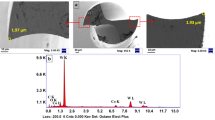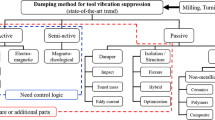Abstract
Machining dynamic stability has been enhanced through a damping coating based on a novel carbon-based nanocomposite material. The coating was synthesized using a plasma enhanced chemical vapor deposition method, and deposited on to the round-shank boring bar used for internal turning and tested during machining. Comparisons between an uncoated and a coated boring bar were carried out at 0.25 mm and 0.5 mm depth of cut using a five times length to diameter ratio overhang, which are typical conditions known to generate detrimental mechanical vibrations. From sound pressure measurement it was found that the measured absolute sound level during process could be reduced by about 90% when using the tool coated with damping layer. Surface roughness measurements of the processed workpiece showed decreased Ra values from approximately 3-6 μm to less than 2 μm (and in 50% of the cases <1 μm) when comparing an uncoated standard tool with its coated counterpart. Moreover, it was found that the addition of an anti-vibration coating did not adversely affect other tool properties, such as rigidity and modularity.














Similar content being viewed by others
References
Y. Altintas and E. Budak, Analytical Prediction of Stability Lobes in Milling, CIRP Annals: Manufacturing Technology, 1995, 44, p 357–362
S.A. Tobias and W. Fishwick, Theory of Regenerative Machine Tool Chatter, The Engineer, 1958, 205, p 199–203
G. Quintana and C. Joaquim, Chatter in Machining Processes: A Review, Int. J. Mach. Tools Manuf., 2011, 51, p 14
A.R. Yusoff, S. Turner, C.M. Taylor, and N.D. Sims, The Role of Tool Geometry in Process Damped Milling, Int. J. Adv. Manuf. Technol., 2010, 50, p 883–895
A. Rashid and C.M. Nicolescu, Design and Implementation of Tuned Viscoelastic Dampers for Vibration Control in Milling, Int. J. Mach. Tools Manuf., 2007, 48, p 1036–1053
E. Marui, S. Ema, M. Hashimoto, and Y. Wakasawa, Plate Insertion as a Means to Improve the Damping Capacity of a Cutting Tool System, Int. J. Mach. Tools Manuf., 1998, 38, p 12
J.H. Wang and K.N. Lee, Suppression of Chatter Vibration of a CNC Machine Centre—An Example, Mech. Syst. Signal Process., 1996, 10, p 551–560
L. Daghini, A. Andreas, and C.M. Nicolescu, Design, Implementation and Analysis of Composite Material Dampers for Turning Operations, International Conference on Mechanical Engineering, Tokyo, Japan, 2009
M.H. Miguélez, L. Rubio, J.A. Loya, and J. Fernández-Sáez, Improvement of Chatter Stability in Boring Operations with Passive Vibration Absorbers, International Journal of Mechanical Science, 2010, 52, p 1376–1384
S.E. Semercigil and L.A. Chen, Preliminary Computations for Chatter Control in End Milling, J. Sound Vib., 2002, 249, p 622–633
L.N.Ld. Lacalle and A. Lamikiz, Machine Tools for High Performance Machining, Springer, London, 2008
N. Olgac and M. Hosek, A New Perspective and Analysis for Regenerative Machine Tool Chatter, Int. J. Mach. Tools Manuf., 1998, 38, p 783–798
M.-S. Hong, K.F. Ehmann, and C.-H. Chiou, The Feasibility of Eigenstructure Assignment for Machining Chatter Control, Int. J. Mach. Tools Manuf., 2003, 43, p 1603–1620
L. Garibaldi and H.N. Onah, Viscoelastic Material Damping Technology, Becchis Osiride, Torino, 1996
D.I.G. Jones, Handbook of Viscoelastic Vibration, Wiley, New York, 2001
J. Suhr, N. Koratkar, P. Keblinski, and P. Ajayan, Viscoelasticity in Carbon Nanotube Composites, Nat. Mater., 2005, 4, p 134–137
N. Koratkar, W. Bingqing, and A.M. Pulickel, Carbon Nanotube Films for Damping Applications, Adv. Mater., 2002, 14, p 997–1000
J. Suhr, K.A. Nikhil, Y. Dexian, and L. Toh-Ming, Damping Properties of Epoxy Films with Nanoscale Fillers, J. Intell. Mater. Syst. Struct., 2006, 17, p 255–261
U.K. Vaidya, P.K. Raju, and W. Kowbel, Material Damping Studies in Carbon–Carbon Composites, Carbon, 1992, 30, p 925–929
M. Zeng, S.W. Or, and H.L.W. Chan, Ultrahigh Anisotropic Damping in Ferromagnetic Shape Memory Ni–Mn–Ga Single Crystal, J. Alloys Compd., 2009, 493, p 565–568
S.A. Golovin, V.A. Kuzmenko, G.D. Petrushin, N.N. Pis’mennyl, and I.I. Renne, Damping Capacity of Cast Iron with Different Shapes of Graphite Inclusions, Strength Mater., 1980, 12, p 360–363
Kouznetsov V, Nicolescu CM, Meza O, Hemmingsson L, Method, Material and Apparatus for Enhancing Dynamic Stiffness. Patent No. WO 2008105736 A2, 2008.
L. Martinu, O. Zabeida, J.E. Klemberg-Sapieha, and P.M. Martin, Handbook of Deposition Technologies for Films and Coatings, 3rd ed., Elsevier, Amsterdam, 2010
D. Lundin and S. Kostas, An Introduction to Thin Film Processing Using High-Power Impulse Magnetron Sputtering, J. Mater. Res., 2012, 27, p 13
K. Vladmir, N. Mihai, H. Åke, and K. Klim, Plasma Activated Chemical Vapor Deposition Method and Apparatus Therefor, US 2011/0081477 A1, 7 Apr 2011, June 18, 2009
B. Angleraud and P.Y. Tessier, Improved Film Deposition of Carbon and Carbon Nitride Materials on Patterned Substrates by Ionized Magnetron Sputtering, Surf. Coat. Technol., 2004, 180–181, p 59–65
N. A. Ruud, R. Karlsen, K. Sørby, and C. Richt, Minimizing Vibration Tendencies in Machining. Modern Machine Shop, 2003, 19 Mar 2003
Mistubish, Technical Data, ed.
S. Kosaraju, V. Gopal. Anne, and Venkateswara Rao, Ghanta; Effect of Rake Angle and Feed Rate on Cutting Forces in an Orthogonal Turning Process, Trends in Mechanical and Industrial Engineering (ICTMIE’2011), Bangkok, 2011
M. Sortino, G. Totis, and F. Prosperi, Development of a Practical Model for Selection of Stable Tooling System Configurations in Internal Turning, Int. J. Mach. Tool Manuf., 2012, 61, p 58–70
M.M. Nigm, A Method for the Analysis of Machine Tool Chatter, Int. J. Mach. Tool Des. Res., 1981, 21, p 251–261
L. Andren, L. Håkansson, A. Brandt, and I. Claesson, Identification of Motion of Cutting Tool Vibration in a Continuous Boring Operation-Correlation to Structural Properties, Mech. Syst. Signal Process., 2004, 18, p 903–927
H. Akaike and Y. Yamanouchi, On the Statistical Estimation of Frequency Response Function, Ann. Inst. Stat. Math., 1962, 14, p 56–89
M. Russ, Sound Synthesis and Sampling, Elsevier Ltd., Oxford, UK/Burlington, USA, 2009
Turning Guidance, Technical Guidance, Ed.: Sumitomo Electric, p 12
Y. Ito, Modular Design for Machine Tools, Part 2, McGraw-Hill Companies, New York, 2008
N7, Surface Finish N Grades Per ISO 1302/1992 N1 N2 N3 N4 N5 N6 N7 N8 ed.
B. Azvinet, G.R. Tomlinsont, and R.J. Wynnet, Use of Active Constrained-Layer Damping for Controlling Resonant, Smart Mater. Struct., 1994, 4, p 1–6
M.D. Rao, Recent Applications of Viscoelastic Damping for Noise Control in Automobiles and Commercial Airplanes, J. Sound Vib., 2003, 262, p 457–474
P.M. Ajayan, J. Suhr, and N. Koratkar, Utilizing Interfaces in Carbon Nanotube Reinforced Polymer Composites for Structural Damping, J. Mater. Sci., 2006, 41, p 7824–7829
R. Asthana, Properties of Cast Composites, Key Eng. Mater., 1998, 115–152, p 351–398
S.A. Golovin, I.I. Renne, and G.D. Petrushin, Peculiarities of the Distribution of Local Microdeformations in Cast Iron with Different Forms of Graphite, Strength Mater., 1979, 11, p 1421–1424
R. Asthana, Interfaces in Cast Composites, Key Eng. Mater., 1998, 151–152, p 301–350
A. Grill, Diamond-like Carbon: State of the Art, Diam. Relat. Mater., 1999, 8, p 428–434
Acknowledgments
The authors wish to thank the late Dr. Vladmir Kouznetsov, who initiated the idea together with Professor Cornel-Mihai Nicolescu to introduce damping coating layers by mixing carbon nano-particles in a metal matrix. This study was supported by Vinnova, Sweden, under the project Eurostars E!4329 NanoComfort.
Author information
Authors and Affiliations
Corresponding author
Rights and permissions
About this article
Cite this article
Fu, Q., Lundin, D. & Nicolescu, C.M. Anti-vibration Engineering in Internal Turning Using a Carbon Nanocomposite Damping Coating Produced by PECVD Process. J. of Materi Eng and Perform 23, 506–517 (2014). https://doi.org/10.1007/s11665-013-0781-y
Received:
Revised:
Published:
Issue Date:
DOI: https://doi.org/10.1007/s11665-013-0781-y




